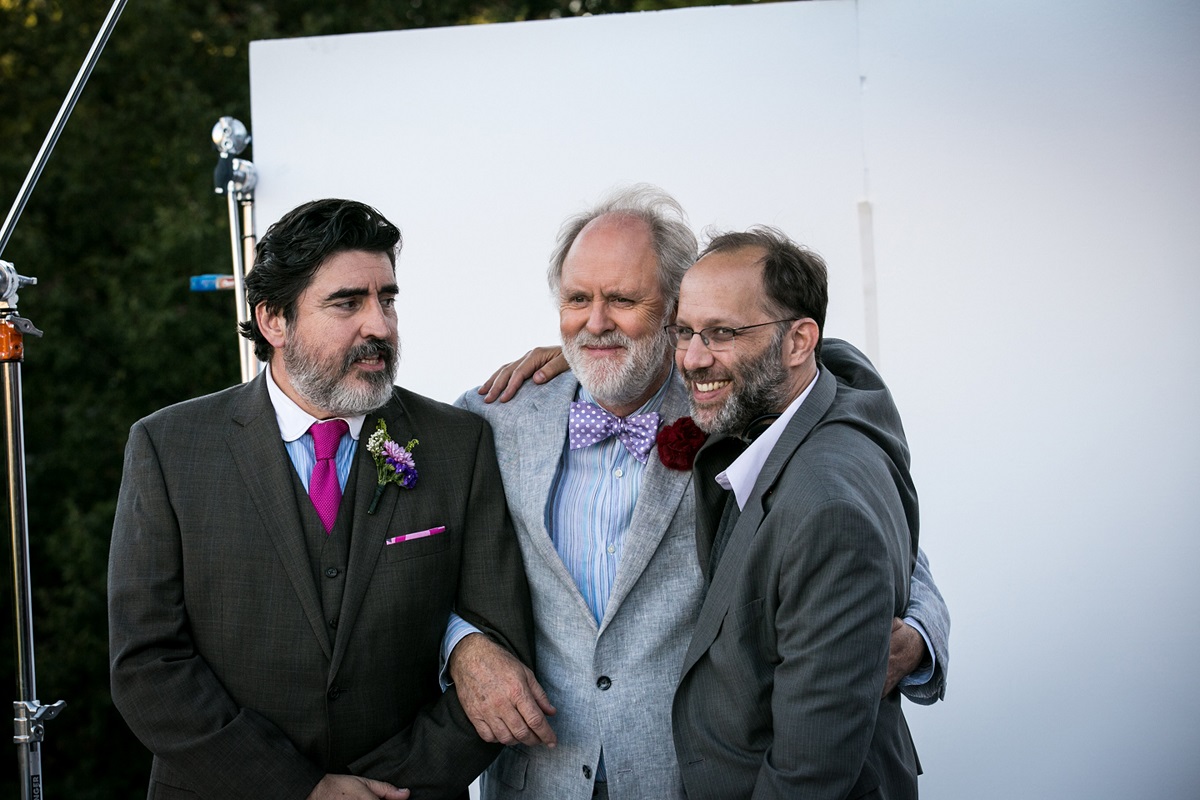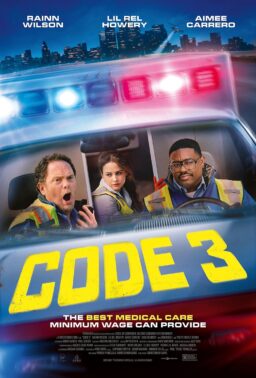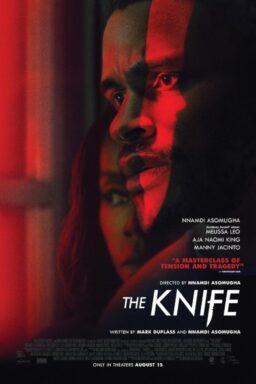In a year where popular pictures marketed as “religious” have cloaked their intolerance in self-righteous anger, Ira Sachs’ gentle, sublimely nuanced character study “Love Is Strange” registers as rather radical. The film centers on Ben (John Lithgow) and George (Alfred Molina), a NYC couple who get married in the 39th year of their relationship. This causes George to get fired from his job as a choir director at a Catholic church, and results in the couple losing their apartment, forcing them to find a place to live. George moves in with neighbors while Ben stays with his nephew (Darren Burrows), his wife (Marisa Tomei) and their son (Charlie Tahan). A day before Sachs’ visit to Chicago for the film’s press interviews, hundreds of parishioners at Holy Family Church in Inverness, IL, voiced their outrage over the firing of their music director, Colin Collette, after he publicly announced his engagement to his male partner. Talk about life imitating art.
Sachs spoke with RogerEbert.com about a variety of topics including the influence of Maurice Pialat on his work, how changes in his personal life have altered his approach to filmmaking, and the statement he wished he hadn’t made to Variety.
George is a Christian whose orientation does not conflict with his faith. His character could be seen as a rebuke to the recent slate of fundamentalist films portraying how Christians are shunned because of their refusal to support gay rights.
Yes, I think you’ve said it very, very well. People have their own beliefs and they come from places that are very deep. Alfred Molina is a very deep person and I think he met George in that spot. There is a kind of trust in his own emotions. I think that one of the reasons Ben and George are such quietly radical and powerful figures is because they know who they are and that’s unwavering. To me, that is where they become really inspiring as gay men and as artists. I think that is really what Marisa Tomei’s character is observing about these two men. It’s this sense of character formed by people who know and love themselves.
The line “love rejoices in truth” is a pointed one in this context, considering that there is a natural tendency for people to feel ashamed if they don’t fit into socially approved identities. Is that a journey that reflects your own life?
It is very much so. I think that all of my previous films were about the nature of love and its destructive toll on an individual, but even more, they were films of self-discovery, about people who were trying to understand who they are and what they felt about that. This is a film that begins with two men who know who they are and they face a conflict together. How they face that conflict is the story of the film and also describes their love. I’ve always thought of it as an epic story told in a New York apartment because it’s multi-generational. It’s really about all these generations, and how at each stage of our life, we know such different things. You have the older couple played by John and Alfred, and then you have Marisa Tomei and Darren Burrows who are very much in the middle of their life, trying to figure out what they are allowed [to do], what they should expect, what they have to give up. Then you have this kid, Charlie Tahan, who is discovering love for the very first time. Each of those perspectives is, to me, what makes love unique and, in some ways, strange.

I was struck by how everyone in George’s church is accepting of his orientation until the news is made public and the Bishop objects.
The church is in a state of flux and state of crisis. It’s clearly a crisis when you look at the history of the Catholic church in the last few years. All history is defined by shifting modes of reality and time and how things change. That’s what I love about cinema. It changes in the moment. One of the things this film speaks to is how relationships are not defined by names or titles but by experience. As a family member, that doesn’t mean anything until you actually look at how it plays out over time and in moments like this, in moments of challenge.
How has your new identity as a husband and parent impacted your outlook on the world and your approach to storytelling?
One of the biggest things that happens to many people when they have kids is that you suddenly realize that you’re not going to last forever. You know there is another generation who are the heroes of their own stories, and that is humbling. I think that this film was in many ways inspired by my mother and my stepfather who have been together for 44 years. I’ve watched that relationship over time and I think something about it has really worked. They are still very much each others’ best friends and there’s a trust between them. I aspire to that within my own relationships. I feel more attentive towards other people at this point in my life, whereas my other films were more about my own internal struggles. Even if the lead character in a film like “Forty Shades of Blue” was a Russian woman living in Memphis, I identified with her conflict.
Like your previous film, “Keep the Lights On,” this film has been praised for not allowing its characters to be defined by their orientation.
I actually hope that just means I’m a good filmmaker. None of us are defined solely by any one adjective and if I was going to write a story that was simplistic or non-nuanced, I would be a different type of artist. I always think of Henry James. It’s not like we are living in the time of James’ “Washington Square” and that [novel] is just about the time in which it was set. If the characters are real, then they go way beyond their moment.
You’ve mentioned that French realism and the films of Ozu have served as influences. I was reminded of “Vertigo” in the way a prolonged fade-out suggests the passage of time.
Let me show you a photograph. [takes out his phone] I happened to be in San Francisco the other day. Look what was outside my window. [On his phone is the hotel where Scottie searches for Madeleine in “Vertigo” and finds a bouquet of her flowers on a car dashboard.] I was in the Fairmont and this is a private apartment across the street. [laughs] I felt like I was on a crane or something.
That is amazing. The building looks just like it did in 1958.
I like a film that makes the audience feel like they are in the middle of life as it is moving, and in a way, they are catching up. They are thrown into things. I have been very influenced by the director Maurice Pialat, who I continue to be in conversation and conflict with and get inspiration from. One of the things I learned from him was this idea that you could make a film out of a series of middles. They’re not necessarily beginnings and ends but always that you’re thrust somewhere and the audience then becomes a part of the world as they try to enter into that space. There is an instinctual sense of what is necessary for a film. I think clarity is one of the most important things in art. I try to give the information that is important without getting in the way of an audience’s more personal response.

Though you go about it in a completely different way, your film and Richard Linklater’s “Boyhood” employ a novelistic style that captures the flow of life, focusing not on obvious moments but on the moments in between. How are you able to achieve this through your various collaborations?
I have a wonderful co-writer, Mauricio Zacharias, and I think we share a lot of similar feelings about both life and cinema. He’s the godfather of my son which means that we come from a place where we look at the world quite similarly, and I think that’s really important. The same is true of my editors Alfonso Gonçalves and Michael Taylor—I’ve been working with Alfonso since my first film—and one of the things that is important to me is that I continue to work with people who are passionate about movies and who share an education in cinema. This picture is a pretty classic neorealist film. It’s a film that, if it works, it makes the ordinary extraordinary, which is the goal of neorealism. It’s based in the real world. That history is one that I feel very much a part of, and it’s still important to me. That’s why I’m really happy to stay in film and not make television, not that anyone is asking me to. It’s a different medium.
Would you consider working for a network like HBO?
Particularly in the case of my last two films, I am a truly independent filmmaker and I am my own boss. As soon as you work in television, you are working for a corporation, so it’s a different experience. I believe in independent film as an economic possibility and also as something that gives you a kind of freedom that is undeniable.
That’s refreshing to hear, considering that there are still many filmmakers sounding the death knell on indie film.
I just said that in Variety and feet really bad about it. I said that independent cinema is dead. I work a lot with the Sundance Institute and I’m thinking they’ll not like that. It’s not a really good thing to say. The modes of production are very, very challenging.
Would you say that the independent film industry is in flux and that a new, sustainable model is on the horizon?
It’s interesting because, yes, we are struggling to figure out what the new model is, but so was Orson Welles and so was John Cassavetes, and that’s sort of what I go back to. When you think about it, the idea that independent film was going to be an explosive possibility for sustained careers is perhaps no longer the case, but there are individuals [who enabled me] to make this movie and helped it find a place in the culture.

One of the most stunning performances in the film is by Charlie Tahan. Many pivotal scenes rest on his shoulders, and he is more than up to the challenge.
I think that kid is a genius, I really do. I couldn’t help thinking of DiCaprio in “Gilbert Grape,” in the sense that you see this raw emotion and talent and craft without any kind of mediation. When he auditioned for the film, he wasn’t an inexperienced actor. He had been in “Charlie St. Cloud” and “Frankenweenie.” There was something that he did in this brief scene that he performed during the audition that made me realize that we had to make the film within the next month. He is right on the verge of becoming a man and it’s so present, and that’s the story of the film. It’s a coming-of-age film and I knew that we needed to capture that. There’s one scene where he has this fight with his family at the dinner table, and we ended up shooting it so that his close-up was the last of the things we shot. I don’t rehearse my films before I start shooting, so I had never seen the scene. I was actually watching the monitor in another room so until it was his close-up, I had never seen him perform the scene, but I had heard him do it 35 times because by then we had done coverage on [the other actors]. When I saw him, I was like, “He’s so authentic in this moment.” I went in and I asked John and Marisa, “Is he like that every time?” And they both turned and went, “Uh huh.” [laughs]
The scene where the camera lingers on Tahan as he’s suddenly overcome with emotion took my breath away.
The film is very musical and it’s influenced by the music of Chopin and the kind of orchestration of effect that can come in a certain piece. I knew that the film would have a certain moment of reflection towards the end that would be different from what we had seen previously. We shot a few different sizes of that scene, but once we cut it, it actually brought the audience out. It disrupted the natural attachment. I love in film where you feel like for a very brief moment, you are in a place that is so intimate, you almost feel like you shouldn’t be there. I always think of this film called “Open Hearts.” It’s a Danish film by Susanne Bier with Paprika Steen, who’s in a couple of my films. There were moments in that film where I felt, “I shouldn’t be watching this. You should not be letting me in there.” I don’t think you can make a whole movie like that. Bergman tried, in lots of ways, to do that, and that’s actually why I don’t go back to Bergman. It’s just too much for me. But in this film, there’s so much humor and a kind of lightness before it comes to land.
There’s a lot of humor but also a great deal of tension generated by the strain of loved ones living in all-too-close of quarters. How were you able to depict that dynamic so authentically?
When I started writing this film with Mauricio, it was in the same month that I went from living alone to living with my husband, our two kids, the kids’ mother and occasional visiting family members who would come to stay and help us out. It was perfect, it was like, “Love is strange!” [laughs]
Tell me about your mentorship program for “young queer filmmakers.”
I think in all my films, I have been very interested in how community defines individual experience. None of my films exist with characters that are in isolation from a particular culture or subculture. I’ve also been aware that as an artist, I’ve had very few models for how to live a life. I’m looking at this image of John Lithgow and Alfred Molina [on the film’s poster], and thinking about what I’ve learned from them as individuals and as creative people, and how important that is to me and my sense of how to proceed. Five years ago, I started a series called Queer Art Film, which is once a month at the IFC Center in New York. It’s a community building series in which we invite artists to pick a film that has been important to them as a queer person but also as a creator. From that, we’ve started this mentorship program which supports ten emerging queer artists in five disciplines: literary, visual, performing arts, film and curatorial, and we pair them with an established artist in their field. It’s all just a way to create “company,” which is a Beckett term. I think “company” is this wonderful term of what we all strive for and hope for and need. In many ways, this film is about mentorship. I think Marisa Tomei and Charlie Tahan are mentored by Ben and George, and that is, as a parent, so important to me. The question that Alfred Molina’s character asks in the letter to the parents of the children [at his church] is, “What do we teach our children?” That sort of question is extremely meaningful to me, and hopefully, to an audience.












